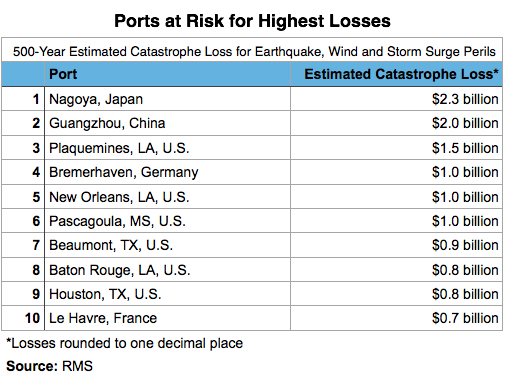Six U.S. ports are among 10 globally at biggest risk of high insurance losses stemming from earthquake, wind and storm-surge catastrophes, according to a new RMS analysis.
The California-based catastrophe modeling firm ranked Plaquemines, Louisiana. as the riskiest U.S. port, at number 3, with $1.5 billion in estimated catastrophe losses under its scenario criteria.
The other U.S. ports placed ranked 5-9 on RMS’s list. Here they are, listed in declining order by port and estimated catastrophe losses: New Orleans, Louisiana ($1 billion); Pascagoula, Mississippi ($1 billion); Beaumount, Texas ($900 million); Baton Rouge, Louisiana ($800 million); and Houston, Texas ($800 million).
 RMS ranked Nagoya, Japan as the riskiest global port in terms of catastrophe loss risks from earthquake, wind and storm surge. The port could generate $2.3 billion in cat losses, RMS said. Coming in at second place: Guangzhou, China, with possible catastrophe losses hitting $2 billion. Bremerhaven, Germany ranked at number 4, with $1 billion in estimated catastrophe losses. Le Havre, France ranked 10th, with estimated catastrophe losses at $700 million.
RMS ranked Nagoya, Japan as the riskiest global port in terms of catastrophe loss risks from earthquake, wind and storm surge. The port could generate $2.3 billion in cat losses, RMS said. Coming in at second place: Guangzhou, China, with possible catastrophe losses hitting $2 billion. Bremerhaven, Germany ranked at number 4, with $1 billion in estimated catastrophe losses. Le Havre, France ranked 10th, with estimated catastrophe losses at $700 million.
Chris Folkman, director of product management at RMS, said that a port’s size and its catastrophe loss potential are not strongly correlated.
“While China may be king for volume of container traffic, our study found that may smaller U.S. ports rank more highly for risk – largely due to hurricanes,” Folkman said in prepared remarks. “Our analysis proves what we’ve long suspected – that outdated techniques and incomplete data have obscured many high-risk locations. The industry needs to cease its guessing game when determining catastrophe risk and port accumulations.”
For the study, RMS calculated the 1-in-500-year loss for each port, incorporating satellite imagery analysis. Its Marine Cargo Model took into account factors including cargo type, precise storage location, storage type and dwell time.
Source: RMS





















 What to Expect in 2026: U.S. P/C Results More Like 2024
What to Expect in 2026: U.S. P/C Results More Like 2024  Viewpoint: Mapping Evolving Regulatory Terrain for MGAs, MGUs and Other DUAEs
Viewpoint: Mapping Evolving Regulatory Terrain for MGAs, MGUs and Other DUAEs  U.S. E&S Outlook No Longer Positive: AM Best
U.S. E&S Outlook No Longer Positive: AM Best  ‘Dream Is in Sight:’ Chamber, Reinsurers, Insurers Urge Florida to Stay the Course
‘Dream Is in Sight:’ Chamber, Reinsurers, Insurers Urge Florida to Stay the Course 














